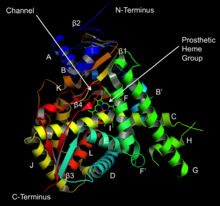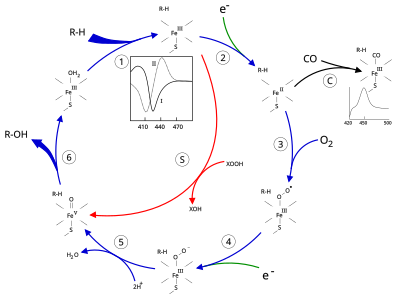Cytochrome P450
| Cytochrome P450 | |||||||||
|---|---|---|---|---|---|---|---|---|---|
 Structure of lanosterol 14α-demethylase (CYP51) | |||||||||
| Identifiers | |||||||||
| Symbol | p450 | ||||||||
| Pfam | PF00067 | ||||||||
| InterPro | IPR001128 | ||||||||
| PROSITE | PDOC00081 | ||||||||
| SCOP2 | 2cpp/SCOPe/SUPFAM | ||||||||
| OPM superfamily | 39 | ||||||||
| OPM protein | 2bdm | ||||||||
| CDD | cd00302 | ||||||||
| Membranome | 265 | ||||||||
| |||||||||
Cytochromes P450(P450sorCYPs) are asuperfamilyofenzymescontaininghemeas acofactorthat mostly, but not exclusively, function asmonooxygenases.[1]However, they are not omnipresent; for example, they have not been found inEscherichia coli.[2]In mammals, these enzymes oxidizesteroids,fatty acids,xenobiotics,and participate in many biosyntheses.[1]By hydroxylation, CYP450 enzymes convert xenobiotics into hydrophilic derivatives, which are more readily excreted.
P450s are, in general, the terminal oxidase enzymes inelectron transferchains, broadly categorized asP450-containing systems.The term "P450" is derived from thespectrophotometricpeak at thewavelengthof theabsorption maximumof the enzyme (450nm) when it is in thereducedstate and complexed withcarbon monoxide.Most P450s require a protein partner to deliver one or moreelectronsto reduce theiron(and eventually molecularoxygen).
Nomenclature
[edit]Genesencoding P450 enzymes, and the enzymes themselves, are designated with theroot symbolCYPfor thesuperfamily,followed by a number indicating thegene family,a capital letter indicating the subfamily, and another numeral for the individual gene. The convention is toitalicizethe name when referring to the gene. For example,CYP2E1is the gene that encodes the enzymeCYP2E1—one of the enzymes involved inparacetamol(acetaminophen) metabolism. TheCYPnomenclature is the official naming convention, although occasionallyCYP450orCYP450is used synonymously. These names should never be used as according to the nomenclature convention (as they denote a P450 in family number 450). However, some gene or enzyme names for P450s are also referred to by historical names (e.g. P450BM3for CYP102A1) or functional names, denoting the catalytic activity and the name of the compound used as substrate. Examples includeCYP5A1,thromboxaneA2synthase, abbreviated toTBXAS1(ThromBoXaneA2Synthase1), andCYP51A1,lanosterol 14-α-demethylase, sometimes unofficially abbreviated to LDM according to its substrate (Lanosterol) and activity (DeMethylation).[3]
The current nomenclature guidelines suggest that members of new CYP families share at least 40%amino-acididentity, while members of subfamilies must share at least 55% amino-acid identity. Nomenclature committees assign and track both base gene names (Cytochrome P450 HomepageArchived2010-06-27 at theWayback Machine) andallelenames (CYP Allele Nomenclature Committee).[4][5]
Classification
[edit]Based on the nature of the electron transfer proteins, P450s can be classified into several groups:[6]
- Microsomal P450 systems
- in which electrons are transferred fromNADPHviacytochrome P450 reductase(variously CPR, POR, or CYPOR).Cytochrome b5(cyb5) can also contribute reducing power to this system after being reduced bycytochrome b5reductase(CYB5R).
- Mitochondrial P450 systems
- which employadrenodoxin reductaseandadrenodoxinto transfer electrons from NADPH to P450.
- Bacterial P450 systems
- which employ aferredoxin reductaseand aferredoxinto transfer electrons to P450.
- CYB5R/cyb5/P450 systems
- in which both electrons required by the CYP come from cytochrome b5.
- FMN/Fd/P450 systems
- originally found inRhodococcusspecies, in which aFMN-domain-containingreductaseis fused to the CYP.
- P450 only systems
- which do not require external reducing power. Notable ones includethromboxane synthase(CYP5),prostacyclin synthase(CYP8), and CYP74A (allene oxide synthase).
The most common reaction catalyzed by cytochromes P450 is a monooxygenase reaction, e.g., insertion of one atom of oxygen into the aliphatic position of an organic substrate (RH), while the other oxygen atom isreducedto water:
Related hydroxylation enzymes
[edit]Manyhydroxylationreactions (insertion ofhydroxylgroups) use CYP enzymes, but many other hydroxylases exist.Alpha-ketoglutarate-dependent hydroxylasesalso rely on an Fe=O intermediate but lack hemes. Methane monooxygenase, which converts methane to methanol, are non-heme iron-and iron-copper-based enzymes.[7]
Mechanism
[edit]
Structure
[edit]The active site of cytochrome P450 contains a heme-iron center. The iron is tethered to the protein via acysteinethiolateligand.This cysteine and several flanking residues are highly conserved in known P450s, and have the formalPROSITEsignature consensus pattern [FW] - [SGNH] - x - [GD] - {F} - [RKHPT] - {P} -C- [LIVMFAP] - [GAD].[8]In general, the P450 catalytic cycle proceeds as follows:
Catalytic cycle
[edit]- Substrate binds in proximity to theheme group,on the side opposite to the axial thiolate. Substrate binding induces a change in the conformation of the active site, often displacing a water molecule from the distal axial coordination position of the heme iron,[9]and changing the state of the heme iron from low-spin to high-spin.[10]
- Substrate binding induces electron transfer from NAD(P)H viacytochrome P450 reductaseor another associatedreductase,[11]converting Fe(III) to Fe(II).
- Molecular oxygen binds to the resulting ferrous heme center at the distal axial coordination position, initially giving adioxygen adductsimilar to oxy-myoglobin.
- A second electron is transferred, from eithercytochrome P450 reductase,ferredoxins,orcytochrome b5,reducing the Fe-O2adduct to give a short-lived peroxo state.
- The peroxo group formed in step 4 is rapidly protonated twice, releasing one molecule of water and forming the highly reactive species referred to asP450 Compound 1(or just Compound I). This highly reactive intermediate was isolated in 2010,[12]P450 Compound 1 is an iron(IV) oxo (orferryl) species with an additional oxidizing equivalentdelocalizedover theporphyrinand thiolate ligands. Evidence for the alternative perferryliron(V)-oxo[9]is lacking.[12]
- Depending on the substrate and enzyme involved, P450 enzymes can catalyze any of a wide variety of reactions. A hypothetical hydroxylation is illustrated. After the hydroxylated product has been released from the active site, the enzyme returns to its original state, with a water molecule returning to occupy the distal coordination position of the iron nucleus.

- An alternative route for mono-oxygenation is via the "peroxide shunt" (path "S" in figure). This pathway entails oxidation of the ferric-substrate complex with oxygen-atom donors such as peroxides and hypochlorites.[13]A hypothetical peroxide "XOOH" is shown in the diagram.
Mechanistic details, including theoxygen rebound mechanism,have been investigated with synthetic analogues, consisting of iron oxo heme complexes.[14]
Spectroscopy
[edit]Binding of substrate is reflected in the spectral properties of the enzyme, with an increase in absorbance at 390 nm and a decrease at 420 nm. This can be measured by difference spectroscopies and is referred to as the "type I" difference spectrum (see inset graph in figure). Some substrates cause an opposite change in spectral properties, a "reverse type I" spectrum, by processes that are as yet unclear. Inhibitors and certain substrates that bind directly to the heme iron give rise to the type II difference spectrum, with a maximum at 430 nm and a minimum at 390 nm (see inset graph in figure). If no reducing equivalents are available, this complex may remain stable, allowing the degree of binding to be determined from absorbance measurementsin vitro[13] C: If carbon monoxide (CO) binds to reduced P450, the catalytic cycle is interrupted. This reaction yields the classic CO difference spectrum with a maximum at 450 nm. However, the interruptive and inhibitory effects of CO varies upon different CYPs such that the CYP3A family is relatively less affected.[15][16]
See also
[edit]Further reading
[edit]- Estabrook RW (December 2003). "A passion for P450s (Remembrances of the early history of research on cytochrome P450)".Drug Metabolism and Disposition.31(12): 1461–1473.doi:10.1124/dmd.31.12.1461.PMID14625342.S2CID43655270.
References
[edit]- ^ab"Cytochrome P450".InterPro.
- ^Danielson PB (December 2002). "The cytochrome P450 superfamily: biochemistry, evolution and drug metabolism in humans".Current Drug Metabolism.3(6): 561–597.doi:10.2174/1389200023337054.PMID12369887.
- ^"NCBI sequence viewer".Retrieved2007-11-19.
- ^Nelson DR (October 2009)."The cytochrome p450 homepage".Human Genomics.4(1): 59–65.doi:10.1186/1479-7364-4-1-59.PMC3500189.PMID19951895.
- ^Nelson DR (January 2011). "Progress in tracing the evolutionary paths of cytochrome P450".Biochimica et Biophysica Acta (BBA) - Proteins and Proteomics.1814(1): 14–18.doi:10.1016/j.bbapap.2010.08.008.PMID20736090.
- ^Hanukoglu I (1996)."Electron transfer proteins of cytochrome P450 systems"(PDF).Adv. Mol. Cell Biol.Advances in Molecular and Cell Biology.14:29–55.doi:10.1016/S1569-2558(08)60339-2.ISBN978-0-7623-0113-3.
- ^Tucci FJ, Rosenzweig AC (February 2024)."Direct Methane Oxidation by Copper- and Iron-Dependent Methane Monooxygenases".Chemical Reviews.124(3): 1288–1320.doi:10.1021/acs.chemrev.3c00727.PMC10923174.PMID38305159.
- ^[1]Archived2019-10-18 at theWayback MachinePROSITEconsensus pattern for P450
- ^abMeunier B, de Visser SP, Shaik S (September 2004). "Mechanism of oxidation reactions catalyzed by cytochrome p450 enzymes".Chemical Reviews.104(9): 3947–3980.doi:10.1021/cr020443g.PMID15352783.S2CID33927145.
- ^Poulos TL, Finzel BC, Howard AJ (June 1987). "High-resolution crystal structure of cytochrome P450cam".Journal of Molecular Biology.195(3): 687–700.doi:10.1016/0022-2836(87)90190-2.PMID3656428.
- ^Sligar SG, Cinti DL, Gibson GG, Schenkman JB (October 1979). "Spin state control of the hepatic cytochrome P450 redox potential".Biochemical and Biophysical Research Communications.90(3): 925–932.doi:10.1016/0006-291X(79)91916-8.PMID228675.
- ^abRittle J, Green MT (November 2010). "Cytochrome P450 Compound I: Capture, Characterization, and C-H Bond Activation Kinetics".Science.330(6006): 933–937.Bibcode:2010Sci...330..933R.doi:10.1126/science.1193478.PMID21071661.S2CID206528205.
- ^abOrtiz de Montellano PR (2005).Cytochrome P450: structure, mechanism, and biochemistry(3rd ed.). New York: Kluwer Academic/Plenum Publishers.ISBN978-0-306-48324-0.
- ^Huang X, Groves JT (March 2018)."Oxygen Activation and Radical Transformations in Heme Proteins and Metalloporphyrins".Chemical Reviews.118(5): 2491–2553.doi:10.1021/acs.chemrev.7b00373.PMC5855008.PMID29286645.
- ^Hopper CP, Zambrana PN, Goebel U, Wollborn J (June 2021). "A brief history of carbon monoxide and its therapeutic origins".Nitric Oxide.111–112: 45–63.doi:10.1016/j.niox.2021.04.001.PMID33838343.S2CID233205099.
- ^Smith AT, Pazicni S, Marvin KA, Stevens DJ, Paulsen KM, Burstyn JN (April 2015). "Functional divergence of heme-thiolate proteins: a classification based on spectroscopic attributes".Chemical Reviews.115(7): 2532–2558.doi:10.1021/cr500056m.PMID25763468.
